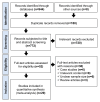Prevalence of Bacterial Pathogens Isolated from Canines with Pyoderma and Otitis Externa in Korea: A Systematic Review and Meta-Analysis
- PMID: 39728996
- PMCID: PMC11680266
- DOI: 10.3390/vetsci11120656
Prevalence of Bacterial Pathogens Isolated from Canines with Pyoderma and Otitis Externa in Korea: A Systematic Review and Meta-Analysis
Abstract
Bacterial skin infections, particularly pyoderma and otitis externa, are widespread in dogs, primarily caused by Staphylococcus and Pseudomonas species. This study evaluates the prevalence and types of bacterial pathogens in affected dogs in South Korea using a meta-analytical approach. Following the PRISMA guidelines, five electronic databases were searched for relevant studies published between 1990 and 2024. Three researchers independently performed data extraction and quality assessment. A subgroup analysis explored the variability in pathogen prevalence across studies based on bacterial genus, bacterial species, publication year, sampling year, sampling location, infection type, diagnostic method, and sample size. Publication bias was evaluated using funnel plots and Egger's regression test, with all analyses conducted using the R program. Of the 944 articles, 29 met the eligibility criteria. The pooled bacterial prevalence among infected dogs was 99.95% (95%CI: 99.85-100). Staphylococcus was the most prevalent genus (95.93%), followed by Pseudomonas (48.43%), Enterococcus (20.32%), and Escherichia (17.63%). The most common species were Staphylococcus pseudintermedius (78.89%), Staphylococcus intermedius (71.43%), and Pseudomonas aeruginosa (46.13%). This study underscores the need for comprehensive treatment strategies targeting Gram-negative and Gram-positive bacteria, emphasizing further research on antimicrobial resistance patterns and treatment efficacy to enhance canine health outcomes in South Korea.
Keywords: bacterial pathogens; dog; meta-analysis; otitis externa; pyoderma; systematic review.
Conflict of interest statement
Author Chongchan Kim was employed by the company Korea Thumb Vet. The remaining authors declare that the research was conducted in the absence of any commercial or financial relationships that could be construed as a potential conflict of interest.
Figures






Similar articles
-
Prevalence of bacterial ear infections and multidrug resistance patterns among ear infection suspected patients in Ethiopia: a systematic review and meta-analysis.BMC Infect Dis. 2024 Nov 28;24(1):1358. doi: 10.1186/s12879-024-10231-4. BMC Infect Dis. 2024. PMID: 39609763 Free PMC article.
-
Tailoring formulation for enhanced phage therapy in canine otitis externa: a cocktail approach targeting Pseudomonas aeruginosa and Staphylococcus pseudintermedius.Vet Microbiol. 2025 Feb;301:110354. doi: 10.1016/j.vetmic.2024.110354. Epub 2024 Dec 24. Vet Microbiol. 2025. PMID: 39740318
-
High prevalence of Fluoroquinolone- and Methicillin-resistant Staphylococcus pseudintermedius isolates from canine pyoderma and otitis externa in veterinary teaching hospital.J Microbiol Biotechnol. 2010 Apr;20(4):798-802. J Microbiol Biotechnol. 2010. PMID: 20467256
-
Prevalence of methicillin resistance in Staphylococcus pseudintermedius isolates from dogs with skin and ear infections in South Africa.J S Afr Vet Assoc. 2022 Jun;93(1):40a-40h. J S Afr Vet Assoc. 2022. PMID: 35950810
-
Bacterial otitis media in sub-Saharan Africa: a systematic review and meta-analysis.BMC Infect Dis. 2020 Mar 17;20(1):225. doi: 10.1186/s12879-020-4950-y. BMC Infect Dis. 2020. PMID: 32183752 Free PMC article.
Cited by
-
Canine Pyoderma and Otitis Externa: A Retrospective Analysis of Multidrug-Resistant Bacterial Carriage in Hong Kong.Antibiotics (Basel). 2025 Jul 6;14(7):685. doi: 10.3390/antibiotics14070685. Antibiotics (Basel). 2025. PMID: 40723988 Free PMC article.
-
Trends in Antimicrobial Resistance of Canine Otitis Pathogens in the Iberian Peninsula (2010-2021).Antibiotics (Basel). 2025 Mar 21;14(4):328. doi: 10.3390/antibiotics14040328. Antibiotics (Basel). 2025. PMID: 40298475 Free PMC article.
-
Whole Genome Sequence Analysis of Multidrug-Resistant Staphylococcus aureus and Staphylococcus pseudintermedius Isolated from Superficial Pyoderma in Dogs and Cats.Antibiotics (Basel). 2025 Jun 25;14(7):643. doi: 10.3390/antibiotics14070643. Antibiotics (Basel). 2025. PMID: 40723946 Free PMC article.
References
-
- Elisa B., Luciana Diegues G.e., Tássia Sell F., Evandro Silva F. Dermatology in Dogs and Cats. In: Rita P.-C., editor. Insights from Veterinary Medicine. IntechOpen; Rijeka, Croatia: 2013. pp. 3–34.
-
- Nocera F.P., Ambrosio M., Fiorito F., Cortese L., De Martino L. On Gram-Positive- and Gram-Negative-Bacteria-Associated Canine and Feline Skin Infections: A 4-Year Retrospective Study of the University Veterinary Microbiology Diagnostic Laboratory of Naples, Italy. Animals. 2021;11:1603. doi: 10.3390/ani11061603. - DOI - PMC - PubMed
-
- Tesin N., Stojanovic D., Stancic L., Kladar N., Ružic Z., Spasojevic J., Tomanic D., Kovacevic Z. Prevalence of the microbiological causes of canine otitis externa and the antibiotic susceptibility of the isolated bacterial strains. Pol. J. Vet. Sci. 2023;26:449–459. doi: 10.24425/pjvs.2023.145052. - DOI - PubMed
-
- Chaudhary A.K., Kumar A., Shrivastva M. Study on prevalence and resistance patterns of bacterial pathogens isolated from canine pyoderma. Int. J. Curr. Microbiol. Appl. Sci. 2019;8:2305–2311. doi: 10.20546/ijcmas.2019.801.241. - DOI
Publication types
Grants and funding
LinkOut - more resources
Full Text Sources
Miscellaneous

